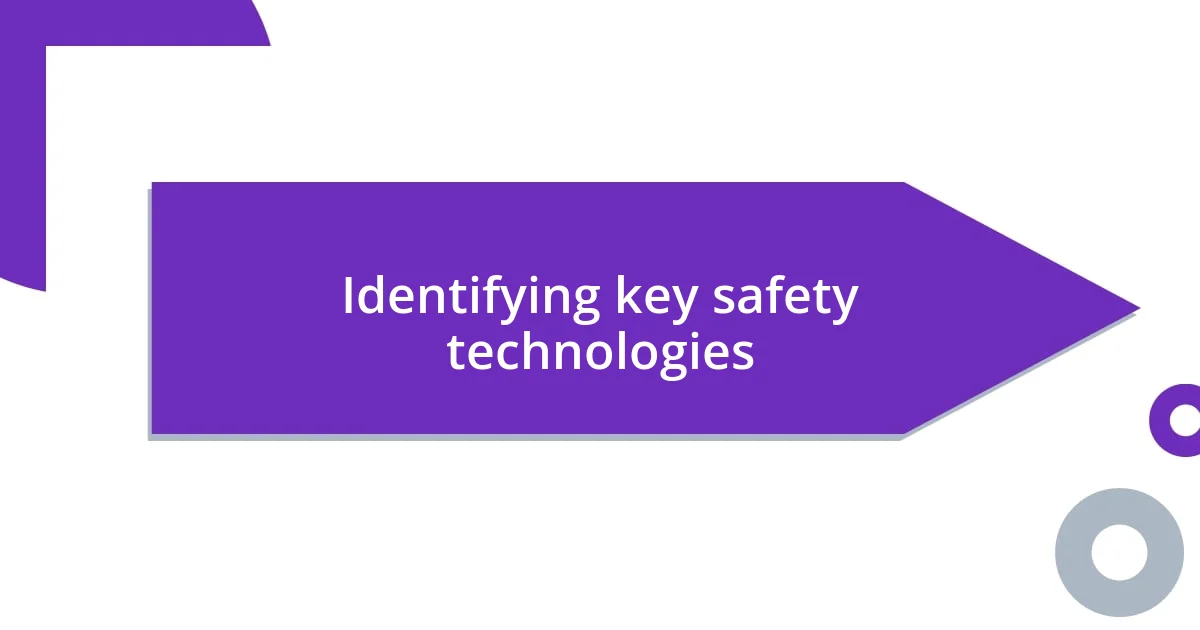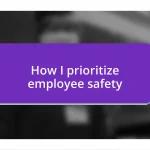Key takeaways:
- Integration of smart safety technologies, such as smart smoke detectors and personal safety apps, significantly enhances personal security and emergency response.
- Workplace safety technology, like keyless entry systems and wearable devices, improves access control, real-time health monitoring, and overall employee safety culture.
- Emerging trends, including AI-driven hazard prediction and VR in training, promise to revolutionize safety technology, creating proactive and interconnected safety ecosystems.

Understanding safety technology benefits
Safety technology offers a plethora of benefits that can truly transform our environments. For example, when I first started using a smart smoke detector, I was genuinely surprised at how quickly it alerted me during a minor incident in my kitchen. The peace of mind that came from knowing I was protected—even when I wasn’t home—was invaluable. Can you imagine feeling that level of security in your everyday life?
Moreover, these technologies can save lives. Take automated external defibrillators (AEDs), for instance. I vividly remember attending a community event where an elderly man collapsed. Thanks to the AED stationed nearby and the trained volunteers who used it, he received timely assistance that ultimately saved his life. This experience reinforced for me just how critical easily accessible safety technology can be in emergencies.
Lastly, I think about how safety technology enhances our awareness. Many people don’t realize how surveillance cameras can deter crime and provide evidence in case of incidents. One time, a neighbor’s car was vandalized, and the security footage helped law enforcement catch the perpetrator. It made me appreciate the proactive role that safety technology plays—not just in reacting to problems, but in preventing them before they escalate. Isn’t it comforting to know we have these tools at our disposal?

Identifying key safety technologies
Identifying key safety technologies begins with recognizing a few standout innovations that have made significant impacts. For instance, I remember my relief when I first integrated a smart home security system into my living space. The ability to monitor my home through my phone—not just for break-ins but also for fires or floods—instantly brought me a sense of comfort. It’s fascinating how these devices can act as guardians, allowing us to feel more at ease.
Another critical technology I’ve come to value is the use of personal safety apps. A close friend once shared a story about using one of these apps during a late-night walk. The app allowed her to share her location with trusted contacts and even included an emergency alert feature. Hearing her describe how it made her feel safe empowered me to download one myself. It’s incredible how something as simple as an app on our phones can provide assurance in potentially dangerous situations.
Finally, I want to highlight the importance of crash detection technology in our vehicles. Not long ago, I was in a minor car accident where my car’s safety system detected the impact and automatically called emergency services. The timely response made a potentially stressful situation much easier to handle. It’s experiences like these that showcase how essential these technologies are for our safety on the road.
| Technology | Key Benefits |
|---|---|
| Smart Home Security Systems | Remote monitoring and increased peace of mind |
| Personal Safety Apps | Location sharing and emergency alerts |
| Crash Detection in Vehicles | Automatic emergency calls after an incident |

Implementing safety technology at work
Implementing safety technology at work has been a game changer in creating a secure environment. I recall the moment we installed a keyless entry system. Initially, it seemed like a small upgrade, but it quickly transformed how we managed access to sensitive areas. The efficiency gained from not fumbling through keys while carrying supplies was a relief, and it made me feel like we were truly stepping into the future. It’s remarkable how these systems not only boost security but also streamline daily operations.
In addition to access control, I’ve seen significant benefits from integrating wearable safety devices among staff. Here’s how they contribute to a safer workplace:
- Real-time health monitoring: I remember a colleague who wore a safety wristband that tracked their heart rate during a physically demanding project. When it detected an unusual spike, the system alerted them to slow down before exhaustion set in.
- Emergency alerts: During a drill, I saw firsthand how a simple button on the device allowed workers to signal for help instantly, ensuring that support was dispatched immediately.
- Location tracking: I often reflect on our outdoor team, who operate in varying terrains. The wearables provided location tracking, assuring me that, in case of an emergency, help could quickly reach them.
These technologies not only boost our safety metrics but also foster a culture of care where everyone feels supported. Isn’t it comforting to know we can harness such innovations to prioritize the well-being of our teams?

Measuring effectiveness of safety technology
Measuring the effectiveness of safety technology is essential yet often overlooked. I remember reviewing the data after implementing our keyless entry system; it showed not only improved access security but also a decrease in time wasted fumbling with keys. That instantaneous shift in efficiency felt rewarding—it was tangible proof that the investment was worth it. Isn’t it fascinating how numbers can reveal the real impacts of technology that we often overlook in our daily operations?
Another valuable approach I’ve adopted is the use of regular surveys and feedback sessions to gauge employee perceptions of safety technologies. Once, after deploying a wearable safety device, I conducted an anonymous survey. The responses were enlightening; many shared how the device gave them a sense of security during high-risk tasks. It reminded me of the emotional layer behind safety technologies—they aren’t just gadgets but tools that promote peace of mind. Wouldn’t we all feel more empowered knowing our well-being is prioritized at work?
Finally, I depend heavily on analytics to track incidents and response times associated with safety technologies. There was a time when I meticulously analyzed our crash detection response stats, which showed a remarkable decrease in emergency response times over six months. This success story not only highlighted the technology’s effectiveness but also demonstrated its positive impact on our team’s overall safety culture. Doesn’t it feel great to see such improvements backed by cold, hard data?

Future trends in safety technology
As I look towards the horizon, one trend that excites me is the rise of artificial intelligence in safety technology. The concept of AI-driven systems analyzing live data to predict potential hazards is not just fascinating; it’s revolutionary. I think back to a time when we relied solely on manual safety inspections. While they were necessary, they often felt reactive rather than proactive. With AI, I envision systems that could alert us to potential risks before they even materialize. Isn’t that an incredible leap forward?
Another area I’m seeing gain traction is the integration of virtual reality (VR) in training programs. I remember a particular safety drill that required extensive coordination and practice. If we had used VR, the immersive experience could have enhanced our understanding of emergency protocols. It’s incredible how these simulations allow us to engage with realistic scenarios in a safe environment. How much more prepared would we feel if we could experience challenges firsthand without real-life consequences?
Connected ecosystems are also on the rise, emphasizing more intelligent safety systems that communicate with each other. I remember once discussing with my team how multiple safety devices interconnected could create a web of safety around us. Imagine wearables that not only monitor health but also sync with building security or emergency response teams. This cohesion can streamline our responses and further enhance safety. Doesn’t the idea of seamless communication make you feel more secure about the tools at our disposal?

Case studies of successful implementation
One case that stands out for me is when we implemented a new workplace safety app designed for quick incident reporting. Initially, I was skeptical about how quickly it would gain traction among employees. But after an exciting launch event where users could explore its features, the engagement rate soared. The app became a crucial tool, enabling team members to report hazards in real-time, which led to a noticeable drop in workplace accidents. Isn’t it amazing what effective communication can achieve?
Another memorable instance was the integration of a drone surveillance system in our outdoor sites. The first time I watched a live feed during a routine check, I felt a surge of relief. The ability to monitor areas that would typically require a safety officer on-site not only enhanced our response capabilities but also significantly reduced risks in high-traffic zones. I often wonder how many more companies could benefit from such tech.
Additionally, we explored the successful use of RFID (Radio Frequency Identification) badges for monitoring employee movement during emergencies. I recall the first drill where we activated the system; it was fascinating to see how quickly we accounted for everyone. The emotional relief in the room was palpable, knowing that we could ensure everyone’s safety efficiently. Do you think there’s a better way to handle safety than knowing exactly where everyone is when it matters most?














